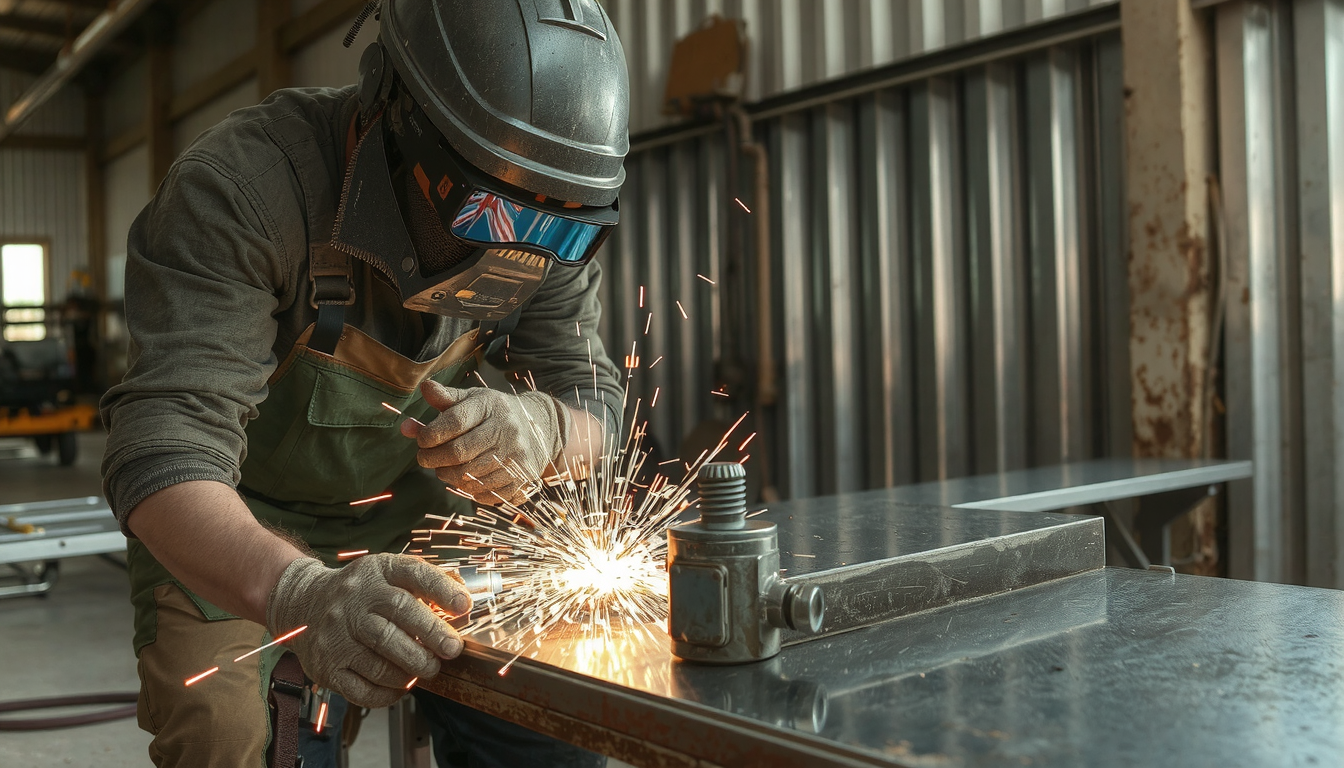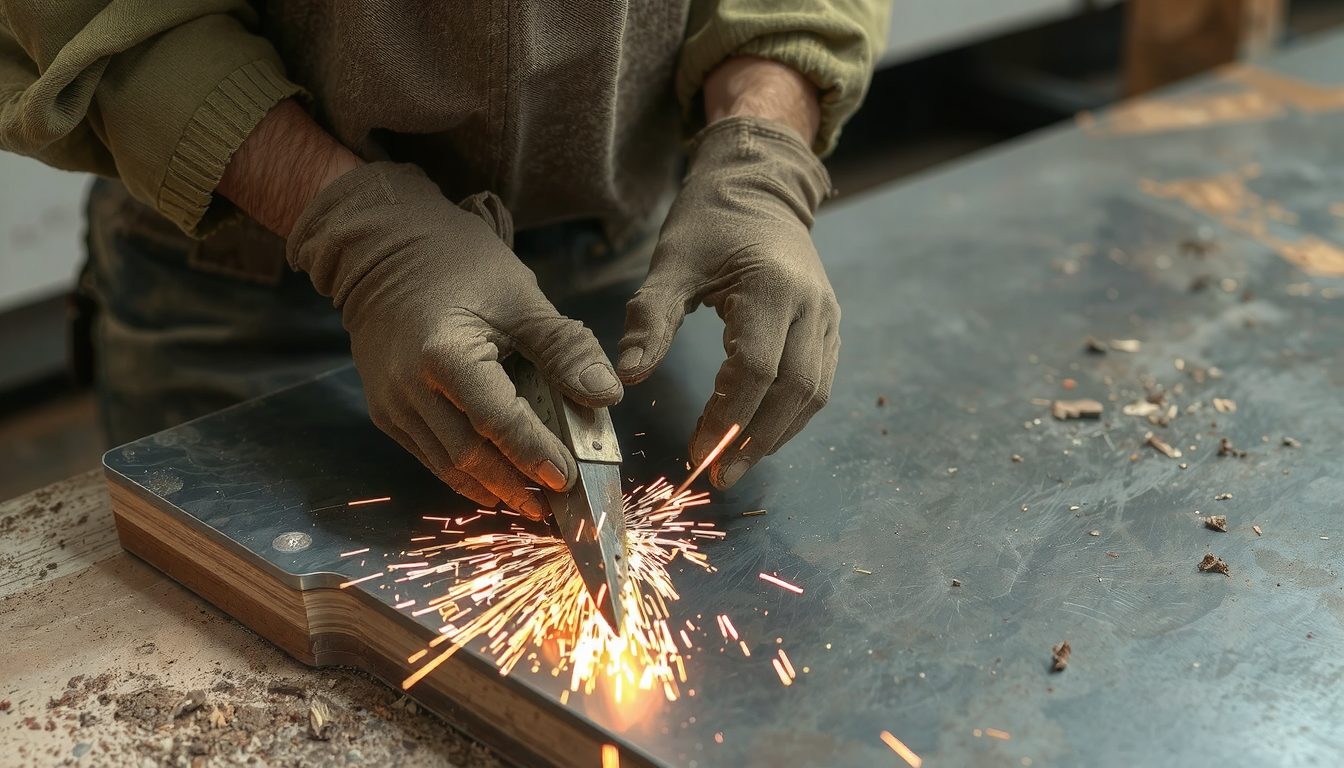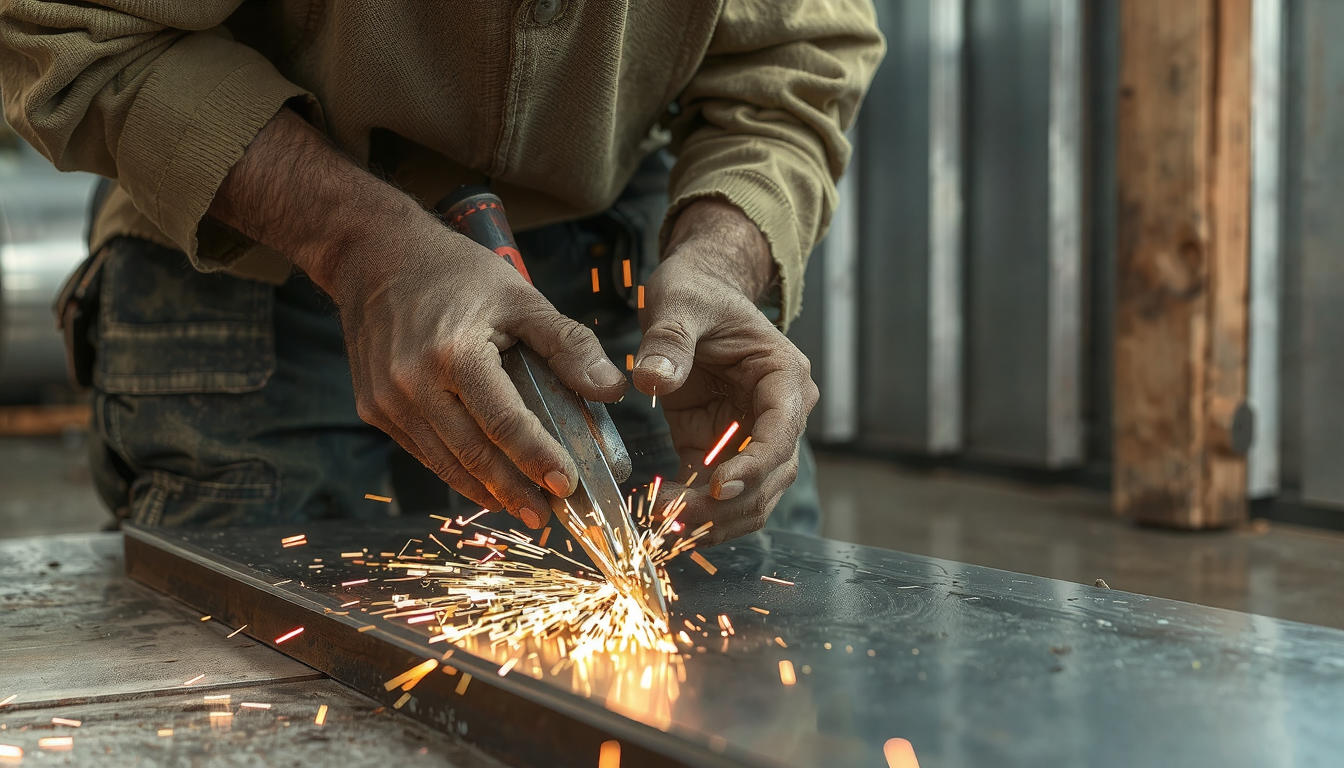Mastering how to cut galvanized sheet metal is an important skill any DIYer or contractor can acquire. It involves having the appropriate tools and safety awareness. Thereafter, you can carry out clean and precise cuts for roofing, duct, or custom projects. This tutorial offers you a precise roadmap. We will cover everything from picking the right tool to some vital safety precautions. We will also show you how to treat the cut edge. This acts as a guarantee for your project’s durability and good craftsmanship.

The knowledge and understanding of the material are the first steps. This guide serves as a comprehensive overview. It brings you up to speed and equips you for your next project.
Before You Cut: Understanding Galvanized Steel
Before you even make your first cut, you have to know what you are dealing with. Galvanized steel is not just plain steel. It is covered by a special protective layer.
Galvanization is a process of applying a layer of zinc to a steel surface. The zinc coating plays the role of a barrier. It keeps the steel underneath safe from the agents that trigger rust and corrosion.
- The zinc coating is the sole element preventing the steel from getting rusted.
- Over time, it gives in to save the steel.
- When you cut the metal, you reveal the uncoated steel on the edges.
The cutting of galvanized steel is mainly through this challenge. For example, heat-intensive processes like grinding could eradicate the zinc coating that is next to the cut. This makes the exposed part become rusty easily. Absorbing this information helps you figure out why some cutting methods and aftercuts are preferred than others.
Safety First: Non-Negotiable Precautions
Concerning cutting metal, safety is not an option. Sharp edges, hot sparks, and invisible fumes are real risks. Wearing the correct protective gear is the key point in metal projects that deal with galvanized steel.
Personal Protective Equipment (PPE) is a Must
You should wear what you would consider your first line of defense. You should never start a cut without the right protection.

- Eye Protection: Always wear safety glasses or, even better, a full-face shield. A tiny metal piece in your eye can cause a major eye injury.
- Hand Protection: Get heavy-duty, cut-resistant gloves. The edges of the cut sheet metal are razor-sharp.
- Respiratory Protection: This is imperative. Heating the zinc coating causes the release of zinc oxide fumes. Inhalation of these fumes leads to the development of a flu-like illness known as “metal fume fever.” The only way to ensure a good lung protection is to wear a respirator N95 or higher.
Workspace Preparation
Your workspace safety measures are as vital as the PPE you wear. Get your area ready before you start.
- Ventilation: Always work in a very well-ventilated area. An open garage door or working outdoors is best. This helps quick clearing of any fumes.
- Fire Safety: Power tools, especially grinders, create a shower of hot sparks. Keep flammable materials like sawdust, rags, and chemicals far away from your work area.
- Secure the Workpiece: Use clamps to firmly secure the sheet metal to a workbench. A sheet that moves or vibrates during a cut is dangerous. It also leads to poor results. For more information, see this expert advice on preparing for a galvanized steel project.
Choosing Your Cutting Tool: A Practical Comparison
The question of how do you cut galvanized sheet metal usually comes down to the tool. The best tool for the job depends on your personal choice. The thickness of the metal is for consideration. Also, the design of the cut (straight or curved), your budget, and the quality of finish you need are very important. There is no single “best” tool for every job.
This table compares the most common tools. It will help you choose the right one for your specific task. Knowing about the various techniques for working with galvanized steel will help you make the best choice.
| Инструмент | Лучшее для | Плюсы | Cons | Pro Tip |
|---|---|---|---|---|
| Tin Snips / Aviation Snips | Thin sheets (<22 gauge), short straight cuts, curves. | No heat/sparks, quiet, inexpensive, good control. | Labor-intensive, can deform edges, limited by thickness. | Use color-coded snips: green for right curves, red for left curves, and yellow for straight cuts. |
| Power Shears / Nibbler | Fast, clean cuts on thin to medium sheets, straight or curved. | Very clean, distortion-free cuts; no heat generated. | More expensive than hand tools. Nibblers create small metal “crescents” that need cleanup. | A nibbler is perfect for starting a cut in the middle of a panel without drilling a pilot hole. |
| Jigsaw (with metal blade) | Intricate shapes and curves in thin to medium sheets. | Versatile for non-linear cuts, can access tight spots. | Slower than other power tools, blades can break, can generate some heat. | Use a fine-toothed bi-metal blade (20-24 TPI). Run the saw at a medium speed to avoid overheating the blade and metal. |
| Angle Grinder (with cutting disc) | Thick sheets, long straight cuts, demolition work. | Very fast, cuts thick material with ease. | Generates extreme heat and sparks, destroying the zinc coating. Noisy and less precise. | This is a last resort. Use it only when speed is the top priority and you are prepared to thoroughly treat the cut edge. |
How to Cut Galvanized Sheet Metal: Step-by-Step Guides
As soon as you have picked your tool and established a safe working environment, you can start your cutting process. Here is a step-by-step guide for the most commonly used methods. By following these steps, you will be able to get a clean and accurate cut.

Method 1: Manual Cutting with Aviation Snips
Aviation snips is a manual cutting method that is mainly recommended for thin sheets (22-gauge or thinner). It is also ideal for the making of curved cuts. It offers great control with no heat or sparks produced.
- Measure and Mark: Use a permanent marker and a quality straight edge or a template. Draw your cut line clearly on the sheet.
- Position and Start: Place the jaws of the snips at the edge of the sheet. Align them with your mark. Make the first small snip to get started.
- Cut with Control: Use short, smooth squeezes. Do not close the blades all the way to the tip. This common mistake creates a jagged, burred edge. Stop your cut about 80% through the blade length.
- Manage the Metal: As you cut, you will feel the metal give way. It is helpful to slightly lift the top piece of metal as you move forward. This prevents the cut edge from binding on the snip’s handle. It allows for a smoother motion.
Method 2: Power Cutting with a Jigsaw
A jigsaw is your best friend for cutting complex shapes, curves, or circles. It works well in thin to medium-gauge galvanized sheets.
- Select the Right Blade: Choose a bi-metal blade designed for cutting sheet metal. A blade with 20-24 TPI (Teeth Per Inch) works best. It provides a smooth cut without grabbing the material.
- Secure the Sheet: Clamp the sheet metal firmly to a workbench. Make sure the cut line hangs over the edge so the blade has a clear path. Placing a piece of scrap wood underneath can help reduce vibration.
- Set the Saw: Turn off the orbital action on your jigsaw. The orbital setting is for aggressive wood cutting. It will cause the blade to jump and chip the metal. Set the saw to a medium speed.
- Cut Smoothly: Start the saw before it touches the metal. Guide the saw base firmly along the surface, following your line. Do not force the tool forward; let the blade do the work.
Method 3: Abrasive Cutting with an Angle Grinder
An angle grinder is a powerful tool for cutting through thick galvanized steel quickly. However, it requires the most safety precautions.
- Equip Full PPE: Because of the intense shower of sparks, a full-face shield is strongly recommended over just safety glasses. Also wear your respirator, gloves, and non-flammable clothing.
- Use a Thin Cutting Disc: Select a thin abrasive disc specifically designed for cutting metal. A thinner disc removes less material. This results in a faster, cleaner cut with slightly less heat.
- Make a Confident Cut: Position yourself in a stable stance. Let the grinder reach its full speed before you make contact with the metal.
- Move Steadily: Apply steady, even pressure and guide the grinder along your marked line. Do not press too hard. Let the speed of the disc do the cutting. Be prepared for a lot of noise and sparks. This method absolutely requires treating the cut edge afterward.
After the Cut: Restoring Corrosion Resistance

Cutting galvanized steel, especially with heat-generating tools, exposes the raw steel edge. If left untreated, this edge will quickly rust. This defeats the purpose of using galvanized metal. This final step is simple but essential for a long-lasting, professional project. Following the Best practices for processing galvanized sheet steel ensures the durability of your work.
- Deburr the Edge: The cutting process often leaves behind a sharp, rough edge called a burr. Carefully use a hand file or a deburring tool to smooth this edge. This makes the piece safer to handle and prepares it for coating.
- Clean the Area: Wipe the cut edge and the surrounding area with a degreaser or a solvent on a clean rag. This removes any oils, metal dust, or marker lines. It ensures the new coating will stick properly.
- Apply Zinc-Rich Protection: The key to restoring protection is to re-apply zinc. Methods like grinding or using a saw burn off the original zinc coating at the cut line. You must replace it to prevent rust.
- Use a Cold Galvanizing Compound: The easiest way to do this is with a zinc-rich spray paint. It’s often called a “cold galvanizing compound.” These products contain a high percentage of zinc dust.
- Apply Thin Coats: Shake the can well and apply two or three thin coats directly to the clean, deburred edge. Allow each coat to dry according to the product’s instructions. This simple action restores the rust-proof barrier.
When to Call the Professionals: Industrial Cutting
For some projects, DIY methods may not be the best choice. For high-volume jobs, extremely thick materials, or cuts that require surgical precision, professional services are the way to go.
Industrial methods offer unmatched accuracy and finish quality. These include:
- Лазерная резка
- Плазменная резка
- Гидроабразивная резка
These tasks are best handled by professional производство листового металла experts. They use advanced machinery. This ensures perfect cuts without compromising the material’s integrity. These services are often part of a larger project. It might include other precision processes like CNC lathe services.
Заключение
You now have a complete understanding of how do you cut galvanized sheet metal safely and effectively. The process is straightforward when you follow a few core principles. First, always choose the right tool for the thickness of your material and the type of cut you need. Second, make safety your top priority. Use the correct PPE and prepare your workspace. Finally, never forget to treat the cut edge with a zinc-rich compound. This restores its rust protection.
This knowledge empowers you to approach your work with skill and care. At MekaLite, we believe in empowering makers with expert knowledge. With these guidelines, you are well-equipped to tackle your next galvanized steel project with confidence.
Frequently Asked Questions (FAQ) about Cutting Galvanized Sheet Metal
1. Can I use a Dremel tool to cut galvanized sheet metal?
Yes, a Dremel tool with a reinforced metal cutting wheel can work for very small, thin pieces. It can also work for cutting intricate details. However, it is a very slow process. It generates significant heat in a small area. It is not practical for long cuts or sheets thicker than 28-gauge. If you use one, treating the hot-cut edge with a zinc coating is essential.
2. What’s the best way to cut corrugated galvanized roofing sheets?
Power shears or a nibbler are the ideal tools for cutting corrugated roofing. They make clean cuts without producing heat or distorting the corrugated profile of the panel. For straight cuts across the ribs, a circular saw with a metal-cutting blade can also work. But it is much louder, creates more heat, and leaves a rougher edge. This will need more cleanup and treatment.
3. What is the maximum thickness of galvanized sheet I can cut with hand snips?
This depends on the quality of your aviation snips and your personal hand strength. Generally, standard hand snips are effective for cutting galvanized steel up to around 22-gauge. For any material thicker than that, it becomes very difficult. It can lead to hand strain, poor cut quality, and warped edges. We highly recommend moving to a powered cutting tool for thicker sheets.
4. What are the symptoms of metal fume fever?
Symptoms of metal fume fever usually appear 4 to 10 hours after you have inhaled zinc oxide fumes. They are very similar to a bad case of the flu. They include fever, chills, headache, body aches, joint pain, and nausea. The condition is usually temporary and resolves within 24-48 hours. However, repeated exposure can have long-term health effects. Always wear a proper respirator (N95 or better) and ensure great ventilation to prevent it.
5. Is it necessary to treat the cut edge if my project is for indoor use only?
While the risk of rapid rusting is lower indoors compared to outdoors, it is still highly recommended. Indoor environments can have high humidity. This is especially true in areas like basements, garages, bathrooms, or workshops. This moisture can still cause the exposed raw steel edge to rust over time. Applying a zinc-rich coating is a quick, easy step. It guarantees a long-lasting, professional finish for your project, regardless of its location.

